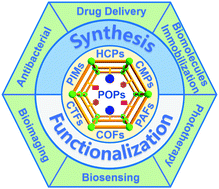Emerging porous organic polymers for biomedical applications
Abstract
Porous organic polymers (POPs) have emerged as a new class of multifunctional porous materials and received tremendous research attention from both academia and industry. Most POPs are constructed from versatile organic small molecules with diverse linkages through strong covalent bonds. Owing to their high surface area and porosity, low density, high stability, tunable pores and skeletons, and ease of functionalization, POPs have been extensively studied for gas storage and separation, heterogeneous catalysis, biomedicine, sensing, optoelectronics, energy storage and conversion, etc. Particularly, POPs are excellent platforms with exciting opportunities for biomedical applications. Consequently, considerable efforts have been devoted to preparing POPs with an emphasis on their biomedical applications. In this review, first, we briefly describe the different subclasses of POPs and their synthetic strategies and functionalization approaches. Then, we highlight the state-of-the-art progress in POPs for a variety of biomedical applications such as drug delivery, biomacromolecule immobilization, photodynamic and photothermal therapy, biosensing, bioimaging, antibacterial, bioseparation, etc. Finally, we provide our thoughts on the fundamental challenges and future directions of this emerging field.

- This article is part of the themed collection: Future Applications and Techniques using Porous Organic Polymers


 Please wait while we load your content...
Please wait while we load your content...